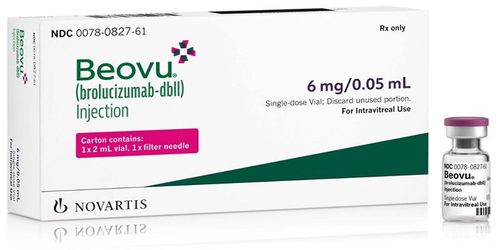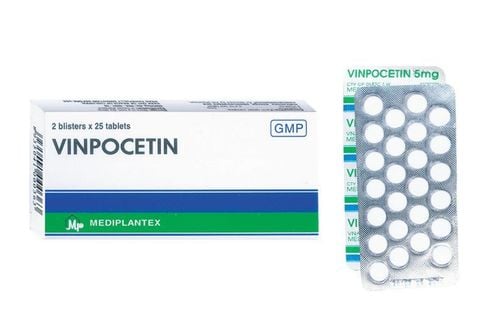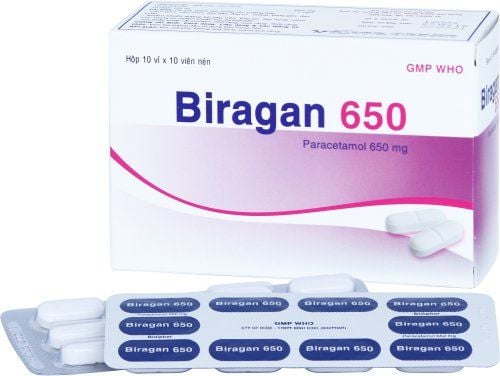This is an automatically translated article.
Vinpocetin 5mg is often used to treat vestibular disorders. This is a prescription drug, patients absolutely should not buy drugs to treat at home because there may be unwanted side effects.
1. What is Vinpocetin 5mg?
Vinpocetin 5mg has a complex action. The drug acts favorably on metabolism and cerebral blood flow as well as on the rheological properties of the blood.
The drug is prepared in the form of tablets with the main ingredient being Vinpocetine.
Pharmacodynamics:
Vinpocetin is a compound with a complex mode of action, with favorable effects on brain metabolism and blood circulation. Vinpocetin has neuroprotective effects: Neutralizes the toxic effects of cellular reactions stimulated by amino acids. Vinpocetin inhibits voltage-dependent Na+ and Ca++ channels as well as NMDA and AMPA receptors. Vinpocetin enhances the neuroprotective effects of adenosine. Vinpocetin stimulates brain metabolism: Vinpocetin helps brain tissue to increase oxygen uptake and utilization by brain cells, improving the transport of glucose - the brain's sole energy source - across the blood-brain barrier; directs glucose metabolism to a more energetically favorable aerobic cycle. Vinpocetin selectively inhibits the enzyme cGMP- phosphodiesterase (PDE) dependent on Ca++ -calmodulin; increased brain cAMP and cGMP levels. Vinpocetin increases ATP concentration and ATP/AMP ratio, increases brain circulation of norepinephrine and serotonin; stimulates the noradrenergic system upward; have antioxidant activity; As a result, Vinpocetin has a protective effect on the brain. Vinpocetin improves cerebral microcirculation: Vinpocetin inhibits platelet aggregation; reduce pathological hyperviscosity; increased erythrocyte distortion and inhibition of erythrocyte adenosine uptake; Increases oxygen transfer into brain tissue by reducing oxygen affinity for red blood cells. Vinpocetin selectively increases cerebral blood circulation: Vinpocetin increases blood pumping to the brain; reduction of cerebral vascular resistance without affecting the parameters of systemic circulation (blood pressure, cardiac output, heart rate, total peripheral resistance); does not have a blood-suppressing effect. While taking the drug, Vinpocetin increases blood supply to areas of the brain that are damaged (but not necrotic) due to local ischemia that is less perfused. Pharmacokinetics:
Absorption: Vinpocetin is rapidly absorbed, peak plasma concentrations are achieved 1 hour after oral administration. The main point of absorption is the proximal side of the digestive tract. Distribution: Vinpocetin is 66% bound to plasma proteins. The absolute oral bioavailability of Vinpocetin is 7%. The volume of distribution is 246 88.51. The clearance value of 3 Vinpocetin (66.7/h) exceeds the plasma value of liver (50 l/h), indicating extrahepatic metabolism. Elimination: During repeated dosing with 5 mg and 10 mg doses, steady-state plasma concentrations of 1.2 0.27 ng/ml and 2.1 0.33 ng/ml were shown, respectively. . The half-life is 4.83 1.29 hours. In studies conducted with radiopharmaceuticals, the major route of elimination was found in urine and faeces with a ratio of 60/40. Metabolism: The major metabolite of Vinpocetin is apovincaminic acid (AVA), which is produced in humans by 25-30%. After oral administration, the AVA AVA is 2-fold larger after intravenous administration indicating AVA production in the first metabolic phase. Other metabolites that have been identified are hydroxy vinpocetin, hydroxyl-AVA, dihydroxy-AVA glycinate and their conjugates with glucuronide or sulphate. Vinpocetin does not require dose adjustment in patients with renal and hepatic disease because its metabolism is not cumulative. Studies have shown that the pharmacokinetics of Vinpocetin in the elderly are not significantly different from those in the young, with no cumulative increase.
2. What are the effects of Vinpocetin 5mg?
Vinpocetine is a drug belonging to the central nervous system group, the neurotropic drug and nervous tonic subgroup. This drug has a “fire-fighting” effect for the condition of the disease.
Orally, the drug helps to reduce the psychiatric and neurological signs of various cerebrovascular disorders (after traumatic or sclerotic conditions) such as:
Memory disorders; Aphasia, inability to use movements and dyskinesia; Dizziness, headache; Treatment of somatic capillary symptoms of postmenopausal syndrome; Encephalopathy is caused by hypertension, intermittent cerebral vascular insufficiency, cerebral vasospasm, and cerebral arteritis; Improves circulation in localized brain injury and in advanced cerebral atherosclerosis. In ophthalmology, the drug can be used to treat:
Primary atherosclerotic disorder; Disorders of the capillaries of the retina and choroidal vessels; Treatment of macular degeneration and glaucoma (glaucoma) secondary to partial or complete thromboembolism; In ophthalmology, drugs are used to treat:
Hearing loss due to vascular causes related to old age or due to intoxication (due to drug use); Dizziness has its origin in the maze. For parenteral use, Vinpocetine is used for the treatment of neurological diseases in acute focal ischemic cerebrovascular disorders, if the source of bleeding can be resolved, and especially as a slow intermittent infusion.
3. Undesirable effects of the drug Vinpocetin 5mg
Cardiovascular: Temporary hypotension, rarely arrhythmia (tachycardia, irregularity). Nervous system: Sleep disturbance, dizziness, headache, weakness. Gastrointestinal: Nausea, heartburn, dry mouth, abdominal pain. Skin: Allergic skin reactions. 4. Drug Interactions with Cavinton (vinpocetine) Taking Vinpocetine with medicines that slow blood clotting may increase the chance of bruising and bleeding. Some drugs that slow blood clotting include Aspirin, Clopidogrel, Diclofenac, Ibuprofen, Naproxen, Dalteparin, Enoxaparin, Heparin, Warfarin, and others.5. How to use Vinpocetin 5mg effectively How to use Vinpocetin 5mg:
The drug is taken orally with a glass of water. Take the drug after a meal because food affects the absorption of the drug. Dosage:
Use dose 5-10 mg x 3 times/day. Maintenance dose: 5 mg x 3 times/day for longer periods. For patients with chronic cerebrovascular disorders, use oral dose of 10 mg x 3 times/day. No dose adjustment is required for patients with hepatic or renal impairment. In the event of an emergency or overdose, immediately call 911 or go to the nearest local health station.
If you forget to take a dose, take it as soon as possible. However, if it is almost time for your next dose, skip the missed dose and take your next dose at the scheduled time. Do not take twice the prescribed dose.
6. Be careful when using the drug Do not use the drug Vinpocetin 5mg for:
Pregnant women; People with severe ischemic heart disease and severe arrhythmia (forbidden to use parenteral route). Due to the sorbitol component in the injection, patients with diabetes must regularly check their blood sugar during treatment.
7. How to store medicine Store at <30oC Keep the medicine out of reach of children and pets in the house. Do not leave the medicine in a place exposed to direct light or in humid places such as the bathroom. Above is information about uses, dosage and usage of Vinpocetin 5mg. To ensure safety and maximize the effectiveness of treatment, patients need to use the drug as prescribed by the doctor.
Please dial HOTLINE for more information or register for an appointment HERE. Download MyVinmec app to make appointments faster and to manage your bookings easily.













